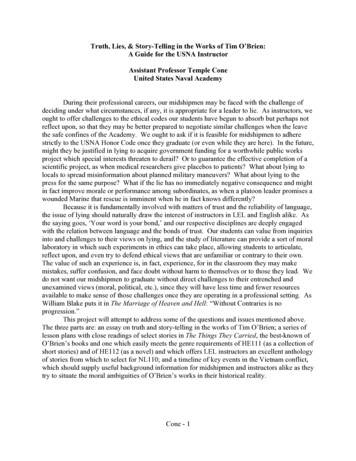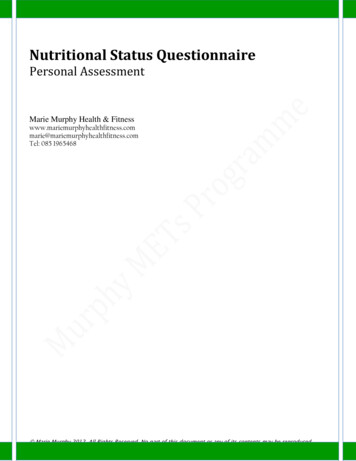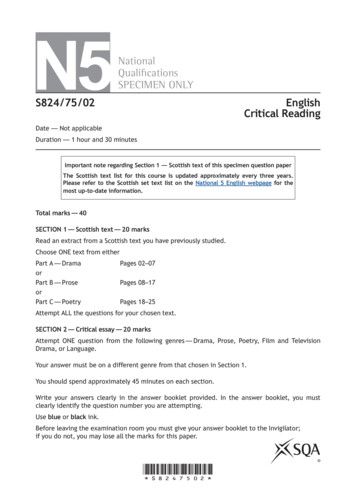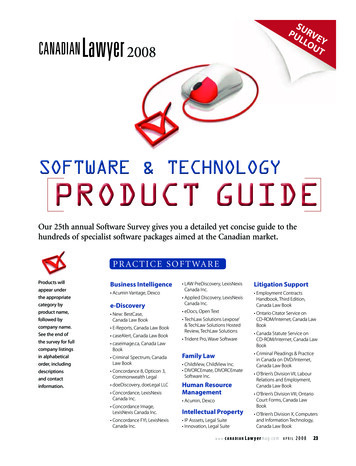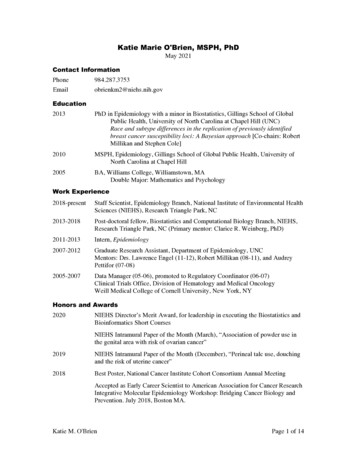
Transcription
Katie Marie O'Brien, MSPH, PhDMay 2021Contact ih.govEducation2013PhD in Epidemiology with a minor in Biostatistics, Gillings School of GlobalPublic Health, University of North Carolina at Chapel Hill (UNC)Race and subtype differences in the replication of previously identifiedbreast cancer susceptibility loci: A Bayesian approach [Co-chairs: RobertMillikan and Stephen Cole]2010MSPH, Epidemiology, Gillings School of Global Public Health, University ofNorth Carolina at Chapel Hill2005BA, Williams College, Williamstown, MADouble Major: Mathematics and PsychologyWork Experience2018-presentStaff Scientist, Epidemiology Branch, National Institute of Environmental HealthSciences (NIEHS), Research Triangle Park, NC2013-2018Post-doctoral fellow, Biostatistics and Computational Biology Branch, NIEHS,Research Triangle Park, NC (Primary mentor: Clarice R. Weinberg, PhD)2011-2013Intern, Epidemiology2007-2012Graduate Research Assistant, Department of Epidemiology, UNCMentors: Drs. Lawrence Engel (11-12), Robert Millikan (08-11), and AudreyPettifor (07-08)2005-2007Data Manager (05-06), promoted to Regulatory Coordinator (06-07)Clinical Trials Office, Division of Hematology and Medical OncologyWeill Medical College of Cornell University, New York, NYHonors and Awards2020NIEHS Director’s Merit Award, for leadership in executing the Biostatistics andBioinformatics Short CoursesNIEHS Intramural Paper of the Month (March), “Association of powder use inthe genital area with risk of ovarian cancer”2019NIEHS Intramural Paper of the Month (December), “Perineal talc use, douchingand the risk of uterine cancer”2018Best Poster, National Cancer Institute Cohort Consortium Annual MeetingAccepted as Early Career Scientist to American Association for Cancer ResearchIntegrative Molecular Epidemiology Workshop: Bridging Cancer Biology andPrevention. July 2018, Boston MA.Katie M. O'BrienPage 1 of 14
2017NIEHS Intramural Paper of the Month (October) “Serum vitamin D and risk ofbreast cancer within five years”2016NIEHS Fellow of the YearBest oral presentation for “Serum vitamin D and risk of breast cancer within fiveyears”, 8 annual SPER/SER Day, National Institute of Environmental HealthSciencesth2015NIEHS Intramural Paper of the Month (November) “Environmental chemicals inurine and blood: Improving methods for creatinine and lipid adjustment”Best poster presentation for “Environmental chemicals in urine and blood:Improving methods for creatinine and lipid adjustment”, 7 annual SPER/SERDay, National Institute of Environmental Health Sciencesth2011Berton H. Kaplan Student Publication Award, Epidemiology DepartmentTeaching and Lecturing:March 2021Guest Lecturer, “Cancer Epidemiology Research in the NIEHS Sister Study”,Epidemiology Seminars course, University of California DavisFebruary 2019 Guest Lecturer, “Epidemiology and the Sister Study”, IDST 184- Researchbeyond Academia, University of North Carolina at Chapel HillJuly 2018Lecturer, NIEHS Science, Teachers and Research Summer InstituteSummer 2016 Co-lead journal club and science workshops for summer intern programInstructor, “Biostatistics I: Introduction to Statistics and Experimental Design”,NIEHS (half-day course)Spring 2016“Vitamin D and Breast Cancer in the Sister Study: An Epidemiology Example”.Guest lecture in “Rx for Science Literacy” presented by the North CarolinaAssociation for Biomedical Research at the National Institutes of EnvironmentalHealth Sciences, Research Triangle Park, NC.Spring 2015Co-Instructor for “Professional Development for Epidemiology Students”,Department of Epidemiology, UNCSpring 2014Primary instructor for “Bayesian Methods in Epidemiology: Basic principles andapplications”, Department of Epidemiology, UNCFall 2013“An introduction to Bayesian methods for epidemiologists.” Guest lecture in“Epidemiologic Analysis of Binary Data”, Dept of Epidemiology, UNCSpring 2010Teaching Assistant, “Theory and Quantitative Methods in Epidemiology”,Department of Epidemiology, UNC2004-2005Teaching assistant, “Elementary Statistics and Data Analysis” and “IntermediateStatistics”, Williams College2003-2004Junior advisor (resident mentor in freshmen dormitory)Teaching assistant, “Quantitative Studies”, and “Elementary Statistics and DataAnalysis”Tutor, calculus and statisticsWilliams College2002-2003Tutor, calculus and statistics, Williams CollegeKatie M. O'BrienPage 2 of 14
Peer-reviewed PublicationsOrcid ID: 0000-0002-1931-1349Google scholar* Shared first author, † Mentee, § Shared senior authorPubMed64. O’Brien KM, Keil AP, Harmon QE, Jackson CL, White AJ, Diaz Santana MV, Taylor JA,and Sandler DP. Vitamin D supplement use and risk of breast cancer by race/ethnicity. Inpress, Epidemiology.63. Kuiper JR, O’Brien KM, Ferguson KK, Buckley JP. Urinary specific gravity measures in theUS population: implications for adjustment of non-persistent chemical urinary biomarkerdata. In press, Environment International.62. Park J, Rodriguez JL, O’Brien KM, Nichols HB, Hodgson ME, Weinberg CR, and SandlerDP. Health-related quality of life outcomes among breast cancer survivors. Cancer, 2021;127(7): 1114-1125.61. O’Brien KM, Tworoger SS, Harris HR, Trabert B, Weinberg CR, Fortner RT, D’Aloisio AA,Kaunitz A, Wentzensen N§, Sandler DP§. Genital powder and uterine cancer: a pooledanalysis. International Journal of Cancer, 2021; 148(11) 2692-2701.60. von Holle A, O’Brien KM, Sandler DP, and Weinberg DR. Evidence for familial clusteringin breast cancer age at onset. International Journal of Epidemiology. 2021; 50(1); 97-104.59. White AJ, Gregoire A, Taylor KW, Eberle C, Gaston S, O’Brien KM, Jackson CL andSandler DP. Adolescent use of hair dyes, straighteners and perms in relation to breast cancerrisk. International Journal of Cancer. 2021; 148: 2255-2263.58. Park YMM, Bookwalter DB, O’Brien KM, Jackson CL, Weinberg CR, and Sandler DP. Aprospective study of type 2 diabetes, metformin use, and risk of breast cancer. Annals ofOncology. 2021; 32(3):351-359.57. von Holle A, O’Brien KM, Sandler DP, Janicek R, and Weinberg CR. Association betweeniron serum biomarkers and breast cancer. Cancer Epidemiology, Biomarkers andPrevention, 2021; 30(2):422-425.56. Nichols HB, Graff M, Bensen JT, Lunetta KL, O’Brien KM, Troester MA, Williams LA,Young K, Hong CC, Yao S, Haiman CA, Ruiz-Narvaez EA, Ambrosone CB, Palmer JR,and Olshan AF. Genetic variants in anti-Mullerian hormone-related genes and breast cancerrisk: results from the AMBER consortium. Breast Cancer Research and Treatment, 2021;185(2): 469-478.55. Upson K, O’Brien KM, Hall JE, Baird DD. Association between urinary cadmiumconcentrations and follicle stimulating hormone in older reproductive-aged women and theimpact of the urinary creatinine adjustment method on results. American Journal ofEpidemiology, 2021; 190(1):116-124.54. Xu J, White AJ, Niehoff NM, O’Brien KM, and Sandler DP. Airborne metals exposure andrisk of hypertension in the Sister Study. Environmental Research, 2020; 191:110144.53. Jia M, Vogtmann E, O’Brien KM, Weinberg CR, Sandler DP and Gierach GL. Theassociation between periodontal disease and breast cancer in a prospective cohort study.Cancer Prevention Research, 2020; 13(12):1007-1016.52. Lawrence KBG, Kresovich JKK, O’Brien KM, Xu Z, Taylor JA, and Sandler DP.Socioeconomic disadvantage and methylation-based biologic age in US women. JAMANetwork Open, 2020; 3(11):e2024329.Katie M. O'BrienPage 3 of 14
51. Goldberg M, D’Aloisio AA, O’Brien KM, Zhao S, and Sandler DP. Pubertal timing andbreast cancer risk in the Sister Study cohort. Breast Cancer Research, 2020; 22(1): 112.50. Fortner RT, Rice MS, O’Brien KM, . Tworoger SS, Schouten LJ. Ovarian cancer riskfactor associations by primary anatomic site: Results from the Ovarian Cancer CohortConsortium. Cancer Epidemiology, Biomarkers, and Prevention, 2020: 29(10):2010-2018.49. Andrew AS, O’Brien KM, Jackson BP, Kaye W, Wagner L, Stommel EJ, Horton K, SandlerDP, Weinberg CR§, and Mehta PF§. Keratinous biomarker of mercury exposure associatedwith amyotrophic lateral sclerosis risk in a population-based U.S. study. AmyotrophicLateral Sclerosis and Frontotemporal Degeneration, 2020; 21(5-6): 420-427.48. White AJ, O’Brien KM, Niehoff NM, Jackson BP, Karagas MR, Weinberg CR, and Keil AP.Toenail metal concentrations and age at menopause: a prospective study. EnvironmentalEpidemiology, 2020; 4(4):e0104.47. Diaz-Santana MV, O’Brien KM, D’Aloisio AA, Regalado G, Sandler DP, and Weinberg CR.Perinatal and postnatal exposures and risk of young-onset breast cancer, overall and byhormone receptor status: results from the Two Sister Study. Breast Cancer Research, 2020;22(1):8846. Schoemaker MJ*, Nichols HB*, O’Brien KM, . Sandler DP§, and Swerdlow AJ§ Adultweight change and premenopausal breast cancer risk: a prospective pooled analysis of datafrom 628,463 women. International Journal of Cancer, 2020; 147(5):1306-1314.45. Bertrand KA, Castro-Webb N, Cozier YC, Li S, O’Brien KM, Rosenberg L, and Palmer JR.Gestational diabetes and risk of breast cancer in African-American women. CancerEpidemiology, Biomarkers and Prevention, 2020; 29(7): 1509-1511.44. Keil AP, Buckley JP, O’Brien KM, Ferguson KK, Zhao S, White AJ. A quantile-based gcomputation approach to addressing the effects of exposure mixtures. Environmental HealthPerspectives, 2020; 128(4):47004.43. Niehoff NM, Keil AP, O’Brien KM, Jackson BP, Karagas MR, Weinberg CR, and White AJ.Metals and trace elements in relation to body mass index in a prospective study of USwomen. Environmental Research, 2020. 184:109396.42. Trabert B, Tworoger SS, O’Brien KM, ., Wentzensen N. Lifetime number of ovulatorycycles and ovarian cancer risk: an analysis from the Ovarian Cancer Cohort Consortium(OC3). Cancer Research, 2020; 80(5):1210-1218.41. Wang C, O’Brien KM, Xu Z, Sandler DP, Taylor JA, and Weinberg CR. Long-term ambientfine particulate matter and DNA methylation in inflammation pathways: Results from theSister Study. Epigenetics, 2020; 15(5): 524-535.40. Shi M, O’Brien KM and Weinberg CR. Interactions between a polygenic risk score and nongenetic risk factors for young-onset breast cancer. Scientific Reports, 2020; 10(1):3242.39. Kresovich JK, O’Brien KM, Xu Z, Weinberg CR, Sandler DP, and Taylor JA. Circulatingimmune cell profiles and breast cancer risk. JAMA Network Open, 2020; 3(1):e1919536.38. O’Brien KM, Tworoger SS, Harris HR, Anderson GL, Weinberg CR, Trabert B, Kaunitz A,D’Aloisio AA, Sandler DP§, Wentzensen N§. Association of powder use in the genital areawith risk of ovarian cancer. Journal of the American Medical Association, 2020; 323(1):4959.37. Kresovich JK, Xu Z, O’Brien KM, Weinberg CR, Sandler DP, Taylor JA. Epigeneticmortality predictors and incidence of breast cancer. Aging, 2019; 11(24):11975-11987.Katie M. O'BrienPage 4 of 14
36. O’Brien KM, D’Aloisio AA, Shi M, Murphy JD†, Sandler DP and Weinberg CR. Perinealtalc use, douching and the risk of uterine cancer. Epidemiology, 2019; 30(6); 845-852.35. Weinberg CR, Shi M, O’Brien KM and Umbach DM. Adjusting for urinary creatinine orserum lipids when analyte assays are based on pooled specimens. Epidemiology, 2019;30(5): 768-779.34. Murphy JD†, Sandler DP, White AJ, and O’Brien KM. Severe acne and risk of breast cancer.Breast Cancer Research and Treatment, 2019; 177(2): 487-495.33. Kresovich JK, Xu Z, O’Brien KM, Weinberg CR, Sandler DP, and Taylor JA. Methylationbased biologic age and breast cancer risk. Journal of the National Cancer Institute, 2019;111(10): djz020.32. O’Brien KM, White AJ, Jackson BP, Sandler DP, Karagas MR, and Weinberg CR. Toenailbased toxic metals and young-onset breast cancer. American Journal of Epidemiology, 2019;188(4): 34-43. [Republished after error correction.]31. O’Brien KM, Sandler DP, Taylor JA, and Weinberg CR. The influence of a breast cancerdiagnosis on serum 25-hydroxyvitamin D. American Journal of Epidemiology. 2019; 188(4):637-645.30. O’Brien KM, White AJ, Sandler DP, Jackson BP, Karagas MR, Weinberg CR. Do postbreast cancer diagnosis toenail metal concentrations reflect pre-diagnostic levels?Epidemiology. 2019; 30(1): 112-119.29. Geller RJ, Brotman RM, O’Brien KM, Fine DM, Zota AR. Phthalate Exposure and Odds ofBacterial Vaginosis among U.S. Reproductive-Aged Women, NHANES 2001-2004.Reproductive Toxicology, 2018; 82:1-9.28. White AJ, O’Brien KM, Niehoff N, and Sandler DP. Metallic Air Pollutants and BreastCancer Risk in a Nationwide Cohort Study. Epidemiology. 2019; 30(1): 20-28.27. O’Brien KM, Taylor JA, Sandler DP, Kinyamu HK, Xu Z, Weinberg CR. Vitamin D, DNAmethylation, and breast cancer. Breast Cancer Research, 2018; 20(1):70.26. Schoemaker MJ , Nichols HB , Wright LB, Brook MN, Jones ME, O’BrienKM, , SandlerDP , Swerdlow AJ . Association of body mass index and age with subsequent risk ofpremenopausal breast cancer. JAMA Oncology, 2018; e181771.*§*§25. Trabert B, Poole EM, , O’Brien K, , WentzensenN, and TworogerSS; on behalf of theOvarian Cancer Cohort Consortium (OC3). Analgesic use and ovarian cancer risk: Ananalysis in the Ovarian Cancer Cohort Consortium (OC3). Journal of the National CancerInstitute, 2019; 111(2):djy100.24. White AJ, O’Brien KM, Jackson BP, Karagas MR. Urine and toenail cadmium levels inpregnant women: a reliability study. Environment International, 2018; 118:86-91.23. O’Brien KM, Sandler DP, Shi M, Harmon QE, Taylor JA, and Weinberg CR. Genome-wideassociation study of 25-hydroxyvitamin D in US women. Frontiers in Genetics, 2018; 9:111.22. Hooper LG, YoungMT, Keller JP, Szpiro AA, O’BrienKM, Sandler DP, Vedal S, KaufmanJD, London SJ. Ambient air pollution exposure and chronic bronchitis in a cohort of U.S.women. Environmental Health Perspectives, 2018; 126(2): 1-9.Katie M. O'BrienPage 5 of 14
21. O’Brien KM, Sandler DP, Kinyamu HK, Taylor JA, Weinberg CR. Single nucleotidepolymorphisms in vitamin D-related genes may modify vitamin D-breast cancerassociations. Cancer Epidemiology, Biomarkers, and Prevention, 2017; 26(12):1761-1771.20. O’Brien KM, Sandler DP, Taylor JA, Weinberg CR. Serum vitamin D and risk of breastcancer within five years. Environmental Health Perspectives, 2017; 125(7):1-9.19. O’Brien KM, Whelan DR†, Sandler DP, Hall JE, and Weinberg CR. Predictors and longterm health outcomes of eating disorders. PLoS One, 2017; 12(7): e0181104.18. Park YMM, White AJ, Nichols HB, O’Brien KM, Weinberg CR, and Sandler DP. Theassociation between metabolic health, obese phenotype and the risk of breast cancer.International Journal of Cancer, 2017; 140(12):2657-2666.17. Park YMM, O’Brien KM, Zhao S, Weinberg CR, Baird DD, and Sandler DP. Gestationaldiabetes mellitus may be associated with increased risk of breast cancer. British Journal ofCancer, 2017; 116(7):960-963.16. O’Brien KM, Whelan DR†, Sandler DP, and Weinberg CR. Eating disorders and breastcancer. Cancer Epidemiology, Biomarkers, and Prevention, 2017; 26(2): 206-211.15. Shi M*, O’Brien KM*, Sandler DP, Taylor J, Zaykin DV, and Weinberg CR. PreviousGWAS hits in relation to young-onset breast cancer. Breast Cancer Research andTreatment, 2017; 161(2): 333-344.14. Gonzalez N†, O’Brien KM, D’Aloisio AA, Sandler DP§, and Weinberg CR§. Talc use,douching and risk of ovarian cancer. Epidemiology, 2016; 27: 797-802.13. O’Brien KM*, Shi M*, Sandler DP, Taylor JA, Zaykin DV, Keller J, Wise AS, andWeinberg CR. A family-based, genome-wide association study of young-onset breastcancer: Germline variants and maternally-mediated effects. European Journal of HumanGenetics, 2016; 24: 1316-1323.12. O’Brien KM, Upson K, Cook NR, and Weinberg CR. Environmental chemicals in urine andblood: Improving methods for creatinine and lipid adjustment. Environmental HealthPerspectives. 2016; 124(2): 220-227.11. O’Brien KM, Sun J†, Sandler DP, DeRoo LA, and Weinberg CR. Risk factors for youngonset breast cancer. Cancer Causes and Control. 2015; 26: 1771-1778.10. O’Brien KM, Fei C, Sandler DP, Nichols HB, DeRoo LA, and Weinberg CR. Hormonetherapy and young-onset breast cancer. American Journal of Epidemiology. 2015; 181: 799807.9. O’Brien KM, Cole SR, Engel LS, Bensen JT, Poole C, Herring AH, and Millikan RC. Breastcancer subtypes and previously established genetic risk factors: A Bayesian approach.Cancer Epidemiology, Biomarkers and Prevention. 2014; 23: 84-97.8. O’Brien KM, Cole SR, Poole C, Bensen JT, Herring AH, Engel LS, and Millikan RC.Replication of breast cancer susceptibility loci in whites and African-Americans using aBayesian approach. American Journal of Epidemiology. 2014; 179: 382-94.7. O’Brien KM, Orlow I, Antonescu CR, Ballman K, McCall L, DeMatteo R, and Engel LS.Gastrointestinal stromal tumors: a case-only analysis of single nucleotide polymorphismsand somatic mutations. Clinical Sarcoma Research. 2013; 3:12.Katie M. O'BrienPage 6 of 14
6. O’Brien KM, Orlow I, Antonescu CR, Ballman K, McCall L, DeMatteo R, and Engel LS.Gastrointestinal stromal tumors, somatic mutations and candidate genetic risk variants, PLoSOne. 2013; 8(4):e62119. doi:10.1371/journal.pone.00621195. Mordukhovich I, Reiter PL, Backes DM, Family L, McCollough LE, O’Brien KM, RazzaghiH, and Olshan AF. A review of African American-white differences in risk factors forcancer: prostate cancer, Cancer Causes and Control. 2011; 3: 341-357.4. O’Brien KM, Cole SR, Tse CK, Perou CM, Carey LA, Foulkes WD, Dressler LG, Geradts J,and Millikan RC. Intrinsic breast tumor subtypes, race, and long-term survival in theCarolina Breast Cancer Study, Clinical Cancer Research. 2010; 16: 6100-6110.3. Pettifor A, O’Brien K, MacPhail C, Miller W, and Rees, H. Early coital debut and associatedrisk factors among young women and men in South Africa, International Perspectives onSexual and Reproductive Health. 2009; 35 (2): 82-90.2. Li T, Christos PJ, Sparano JA, Hershman DL, Hoschander S, O’Brien K, Wright JJ, and VahdatLT. Phase II trial of the farnesyltransferase inhibitor tipifarnib plus fulvestrant in hormonereceptor-positive metastatic breast cancer: New York Cancer Consortium Trial P6205, Annalsof Oncology. 2009; 20: 642-647.1. Gorgun E, Remzi FH, Montague DK, Conner JT, O’Brien K, Laparo B, and Fazio VW. Malesexual function improves after ileal pouch anal anastomosis, Colorectal Disease. 2005;7:545-550.Large consortia-based papers as middle author10. Domchek SM, Yao S, Chen F . Couch FJ, Polley EC, and Palmer JR on behalf of theCARRIERS Consortium [includes O’Brien KM]. Similar prevalence of germlinepathogenic variants in cancer susceptibility genes in U.S. Black women and U.S nonHispanic white women with breast cancer. In press, JAMA Oncology.9. Adedokun B, Du A, Gao G, O’Brien KM, Palmer JR, Haiman CA, Huo D. Crossancestry GWAS meta-analysis identifies six new loci for breast cancer in women of Africanand European ancestry. In press, Nature Communications.8. Kapoor PM, Mavaddat N, . O’Brien KM, . Garcia-Closas M, and Chang-Claude J.Combined associations between polygenic risk score and classical risk factors with breastcancer risk. Journal of the National Cancer Institute. 2021; 113(3): 329-337.7. Coignard J, Lush M, O’Brien KM . , Andrieu N, and Antonis AC. A case-only study foridentifying genetic modifiers of breast cancer specifically for BRCA1/2 mutation carriers.Nature Communications, 2021; 12(1):1078. Correction (author name) published May 2021.6. Hu C, Hart SN, Gnanaolivu R, Huang H, Lee KY, Na J, Gao C, Lilyquist J, Yadav S, ,O’Brien KM, ., Weitzel JN, Goldgar DE, Domchek SM, Nathanson KL, Kraft P, PolleyEC, and Couch FJ. Population-based risks of breast cancer for variants in cancerpredisposition genes. New England Journal of Medicine, 2021; 384(5):440-451.5. Jackson SS, Adami HO, Andreotti G, Beane-Freeman LE, , O'Brien KM, , McGlynn KA,Campbell PT, and Koshiol J. Associations between reproductive factors and biliary tractcancers in women from the Biliary Tract Cancers Pooling Project. Journal of Hepatology,2020; 73(4):863-872.4. Kapoor PM, Lindstroem S, O’Brien KM, Milne RL, Chang-Claude J. Assessment ofinteractions between 205 breast cancer susceptibility loci and 13 established risk factors inKatie M. O'BrienPage 7 of 14
relation to breast cancer risk, in the Breast Cancer Association Consortium. InternationalJournal of Epidemiology, 2020; 49(1): 216-230.3. McGee EE, Campbell PT, Petrick JL, Van Dyke AL, ., O’Brien KM, . McGlynn KA, andKoshiol J. Smoking, alcohol, and biliary tract cancer risk: a pooling project of 26prospective studies. Journal of the National Cancer Institute. 2019; 111(12): 1263-1278.2. Jackson SS, Van Dyke AL, Zhu B, Pfeiffer RM, Petrick JL, , O’Brien KM, , McGlynnKA, Campbell PT, and Koshiol J. Anthropometric risk factors for cancers of the biliary tractin the Biliary Cancers Pooling Project. Cancer Research, 2019; 79(15): 3973-3982.1. Grant DJ, Manichaikul A, , O’Brien KM, , Kennedy CJ, and Schildkraut JM. Evaluationof vitamin D biosynthesis and pathway target genes reveals UGT2A1/2 and EGFRpolymorphisms associated with epithelial ovarian cancer in African American Women.Cancer Medicine, 2019; 8(5): 2503-2513.Invited Commentaries, Editorials, Reviews, Letters, or ArchivedManuscripts (not Peer-Reviewed)4. Keil AP, Buckley JP, O’Brien KM, Ferguson KK, Zhao S, and White AJ. Response to“Comment on ‘A Quantile-based g-Computation Approach to Addressing Effects ofExposure Mixtures”. Environ Health Perspect. 2021; 129(3): 38002.3. O’Brien KM, Sandler DP and Wentzensen N. In reply: genital powder use and ovarian cancer.JAMA. 2020; 323(20): 2096-2097.2. O’Brien KM and Keil AP. Design and interpretation considerations in registry-based studies.JAMA Psych. 2020; 77(1): 15-16.1. O’Brien KM, Upson K, Buckley JP. Lipid and creatinine adjustment to evaluate health effectsof environmental exposures. Current Environmental Health Reports. 2017; 4 (1): 44-50.Fellowships, Grants, and Contracts2019- 2020Received 100,000 grant for “Vitamin D and Breast Cancer in African-Americanwomen: A prospective cohort study” from the Office of Dietary SupplementResearch Scholars Program (Principal Investigator)2017-2018“The influence of β-carotene supplements, dietary and circulating carotenoids onoxidative stress, inflammation, and risk of postmenopausal breast cancer in theSister Study” Office of Dietary Supplement Research Scholars Program(Collaborator; Principal Investigator: Yong-Moon Park)2016- 2017“Vitamin D levels over time and the risk of breast cancer” National Institute ofEnvironmental Health Sciences, Division of Intramural Research (Post-doctoralfellow, Principal Investigator: CR Weinberg)2015- 2017“The Role of Cadmium and Other Trace Elements in Young-onset BreastCancer” National Institute of Environmental Health Sciences, Division ofIntramural Research (Post-doctoral fellow, Principal Investigator: CR Weinberg)2014- 2015Received 100,000 grant for “The Joint Effects of Vitamin D, Genetics, andEpigenetics in the Prevention of Breast Cancer” from the Office of DietarySupplement Research Scholars Program (Principal Investigator)2011- 2013Recipient of NIH Cancer Education and Career Development ProgramInstitutional Training Grant (5R25CA057726-19)Katie M. O'BrienPage 8 of 14
2008- 2011Recipient of NIH National Research Service Award Institutional Training Grantfor Cancer Epidemiology (5T32CA009330-30)Professional ServicePolicy coordinator and COVID-19 response leader, First Environments Early Learning Center,Research Triangle Park, NC (2020-present)NCI Cohort Consortium Associate Member Council (2021); AMC member since 2019Alumni Association Co-president, University of North Carolina at Chapel Hill, Department ofEpidemiology (July 2016 to June 2017)Reviewer for The American Journal of Epidemiology; Epidemiology; Endocrine-related Cancer;International Journal of Molecular Sciences; Scientific Reports; PLoS One; InternationalJournal of Environmental Research and Public Health; European Journal of HumanGenetics; Cancer Epidemiology, Biomarkers and Prevention; British Journal of Cancer;Environmental Health Perspectives, Journal of the National Cancer Institute; Cancer Causesand Control; Nutrients; International Journal of Cancer; JAMA PsychiatryNIEHS Trainees’ Assembly Steering Committee, Representative for the Biostatistics andComputational Biology Branch (May 2014-October 2016)Society for Epidemiologic Research- Student and Post-Doc Committee, Membership andNominations Committee Co-Chair (2009-2011); SER member since 2009International Genetic Epidemiology Society- Next Generation, Co-Founder and board member(2011-2013); IGES website administrator (2012-2013)MentoringPost-doctoral Trainees:Ann Von Holle, PhDBiostatistics and Computational Biology Branch, NIEHSSecondary mentor (Primary mentor: Clarice Weinberg)Mary Diaz Santana, PhDBiostatistics and Computational Biology Branch, NIEHS(Primary mentor: Clarice Weinberg)Pre-doctoral Trainees:Yilda Macias, NIEHS Summers of Discovery 2021, as Master’s student at New Mexico StateUniversity. Primary mentor for “Vitamin D and COVID-19”.Current position: Master’s student at New Mexico State UniversitySharonda Lovett, NIEHS Summers of Discovery 2021, post-Master’s Degree from University ofSouth Florida. Co-mentor (with Dale Sandler) for “Gynecologic surgery, hormone therapy use,and breast cancer risk by race/ethnicity”.Current position: will start PhD program in Fall 2021John Murphy, NIEHS Summers of Discovery 2018 as UNC doctoral student. Primary mentor on“Severe acne and risk of breast cancer”Current position: Doctoral student in Department of Epidemiology, UNC-Chapel HillWinner: 2018 Summer Internship Program Poster Competition (Graduate Level)Katie M. O'BrienPage 9 of 14
Gloria Regalado, NIEHS Summers of Discovery 2016 as North Carolina State undergraduateCo-mentor (with Clarice Weinberg) on “Perinatal and pregnancy-related risk factors for youngonset breast cancer”Completed MS in Analytics at the Institute of Advanced Analytics, NC State UniversityCurrent Position: Associate Consultant at Beghou ConsultingWinner: 2016 NIEHS Presentation ChallengeNicole Gonzalez, NIEHS Summers of Discovery 2015 and part-time intramural research trainee(September 2015-September 2016) as UNC undergraduateCo-mentor (with Clarice Weinberg) on “Talc use, douching and risk of ovarian cancer”Completed MS in Epidemiology, George Washington University, Milken School of Public HealthCurrent Position: Post-baccalaureate Research Fellow, National Cancer InstituteDenis Whelan, NIEHS Summers of Discovery 2014 as Villanova undergraduateCo-mentor (with Clarice Weinberg) on “Eating disorders, and breast cancer” and “Young-onseteating disorders and reproductive outcomes”Completed MS in Biostatistics at Rollins School of Public Health, Emory UniversityCurrent position: Data Scientist at Covera HealthJenny Sun, NIEHS Summers of Discovery 2013 as UNC undergraduateCo-mentor (with Clarice Weinberg) on “Risk factors for young-onset breast cancer”Completed MS and PhD in Epidemiology, Harvard UniversityCurrent Position: Postdoctoral Research Fellow, Harvard Medical School, Harvard PilgrimHealth InstituteInvited TalksVitamin D and risk of breast cancer by race/ethnicity. Office of Dietary Supplements 25thAnniversary Scientific Symposium, October 2021.Vitamin D and risk of breast cancer by race/ethnicity. Office of Dietary Supplements, ResearchScholars Program Symposium, May 2021.Toenail metals and breast cancer: Lessons learned, University of North Carolina at Chapel Hill,NC, April 2020Genetic and Environmental Determinants of Breast and Ovarian Cancer, Epidemiology Branch,National Institute of Environmental Health Sciences, Research Triangle Park, NC, February2017.Vitamin D and Breast Cancer. School of Public Health, Division of Epidemiology andCommunity Health, University of Minnesota, Minneapolis, MN, December 2016.The Joint Effects of Vitamin D, Genetics, and Epigenetics in the Prevention of Breast Cancer.Department of Epidemiology, University of North Carolina at Chapel Hill, NC, October 2016.Vitamin D and Breast Cancer. Zilber School of Public Health, University of Wisconsin atMilwaukee, WI, January 2016.The Joint Effects of Vitamin D, Genetics, and Epigenetics in the Prevention of Breast Cancer.Office of Dietary Supplements Research Scholars Symposium, National Institutes of Health,Bethesda, MD, November 2015.Vitamin D and Breast Cancer. Department of Epidemiology, Geisel School of Medicine,Dartmouth College, Hanover, NH, October 2015.Katie M. O'BrienPage 10 of 14
Vitamin D and Breast Cancer. University of Washington School of Public Health, Department ofEpidemiology, Seattle, WA, September 2015.Breast cancer etiology: Moving from G to E to G by E. Division of Epidemiology, Department ofMedicine, Vanderbilt University School of Medicine, Nashville, TN, July 2015.Environmental biomarkers: Methods and applications. Epidemiology Branch, National Instituteof Environmental Health Sciences, Research Triangle Park, NC, June 2015.Environmental biomarkers: Methods and applications. Department of Epidemiology, Biostatisticsand Occupational Health, McGill University, Montreal, Quebec, Canada, May 2015.Environmental chemicals in urine and blood: Methods for creatinine and lipid adjustment.Biostatistics and Computational Biology Branch, National Institute of Environmental HealthSciences, Research Triangle Park, NC, April 2015.Breast cancer etiology: Moving from G to E to G by E. Department of Epidemiology, Universityof California, Berkeley, CA, February 2015.Breast cancer epidemiology: Heterogeneity by age, race, and genetic profile. Department ofEpidemiology, Biostatistics and Preventive Medicine, University of New Mexico,Albuquerque, NM, August 2014.Race and subtype differences in the replication of previously identified breast cancersusceptibility loci: A Bayesian approach. Biostatistics Branch Seminar, National Institute ofEnvironmental Health Sciences, October 2012.Conference PresentationsCirculating vitamin D co
2018 Best Poster, National Cancer Institute Cohort Consortium Annual Meeting . Accepted as Early Career Scientist to American Association for Cancer Research Integrative Molecular Epidemiology Workshop: Bridging Cancer Biology and Prevention. July 2018, Boston MA. Katie M. O'Brien Page 1 of 14
